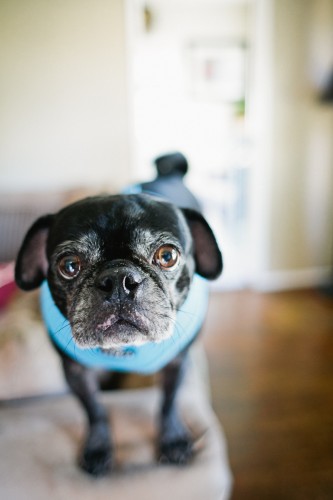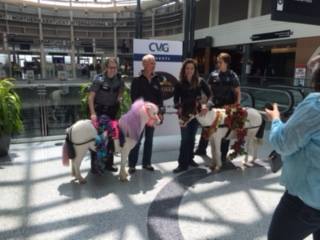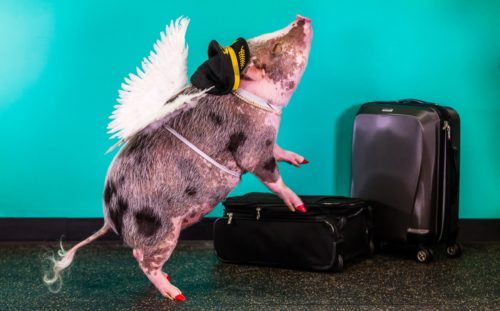Airports are going to the dogs – and to the pigs.
More than 30 airports around the country now have regular programs that bring certified pet therapy dogs and their handlers into the terminals to mingle with passengers and help ease the stress of traveling.
And during 2016, some airport pet therapy teams broadened their membership beyond dogs.
Last summer, when passengers were encountering excessively long lines at security checkpoints at many airports around the country, Cincinnati/Northern Kentucky International Airport began welcoming miniature therapy horses and their handlers to visit several times a month.
And as the winter holiday travel season went into high gear, two airports announced that pigs were joining their pet therapy teams.
LiLou, a Juliana-breed pig, joined San Francisco International Airport’s Wag Brigade.
And a pot-bellied pig named Bacon Bits is now part of Albany International Airport’s Canine Ambassador program.
More animals in the air
Of course, not all the animals you see in airport terminals these days are just there to be petted.
According to the American Pet Products Association, there are around 77 million pet dogs and 85 million pet cats in the United States — and a growing number of their owners take them along when they travel by air.
And when they fly as carry-on passengers in the cabin, those pets need to have tickets.
On Alaska Airlines and JetBlue, the domestic fee for a pet in the cabin is $100 each way. On American Airlines, Delta Air Lines and United Airlines, its $125 each way. Frontier Airlines charges $75 each way, and on Southwest the fee is $95 each way.
In some cases, more than one small pet can travel in a pet carrier (and avoid an extra fee), but some airlines will tack on an extra fee if there’s a stopover of more than four hours.
Emotional support animals
The costs to take a pet on a plane can add up, which may be part of the reason an increasing number of passengers are claiming that their animals aren’t just pets but official service or “emotional support” animals which, by law, get to fly for free.
Like Frontier Airlines, which had an issue earlier this year with a passenger’s emotional support marmoset, each airline website lists very specific conditions under which they will accept service animals or therapeutic/emotional support animals on their plane.
An official identification card and/or a written statement from a mental health professional is usually required, but many websites make it easy for pet owners to acquire ‘fake’ documentation — for a fee.
“It doesn’t matter if it’s a duck or a mini horse, as long as a passenger has the correct paperwork, they’re allowed to fly with an emotional support animal and nobody can say anything about it,” said veteran flight attendant Heather Poole, author of Cruising Attitude.
Poole says it’s not a flight attendant’s job to determine which passengers are flying with true support animals or which ones have simply secured paperwork to avoid paying a fee for their pet to fly, but “I can spot a fake emotional support animal a mile away,” said Poole. “It’s usually growling or barking at other support animals. That, or it’s dressed nicer than its owner.”
2017 may bring changes — or at least some clarification — in how airlines and passengers define service or emotional support animals.
While noting that its ACCESS Advisory Committee was unable to reach agreement on updated rules regarding service animals, the U.S. Department of Transportation recently said it intends to draft its own rules.
“The guide dog and animal training groups all agree this is a problem, so does the community,” said Eric Lipp of the Open Doors Organization. “One solution floated is to have a national registry and certification for service animals so they are given ID. The DOT could also fine a passenger and make big news. That would help, but who wants to do that?”
(A slightly different version of my story about animals in airports and on airplanes first appeared on NBC News Travel.)
Thanks for visiting Stuck at the Airport. Subscribe to get daily travel tidbits. And follow me on Twitter at @hbaskas and Instagram.


